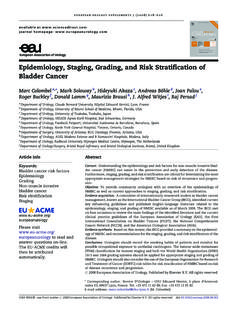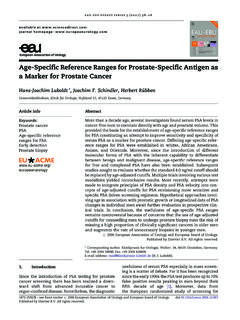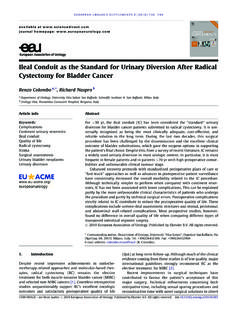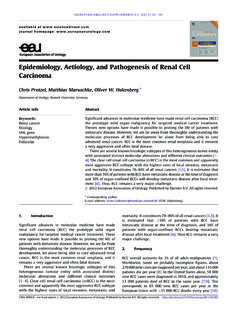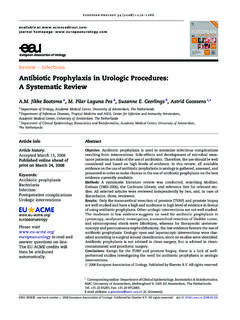Transcription of Managing Complications after Midurethral Sling …
1 Eau-ebu update series 5 (2007) 232 240. available at journal homepage: Managing Complications after Midurethral Sling for Stress Urinary Incontinence Elisabetta Costantini *, Massimo Lazzeri, Massimo Porena Department of Medical-Surgical Specialties and Public Health, Section of Urology and Andrology, University of Perugia, Perugia, Italy Article info Abstract Keywords: Since Ulmsten and Petros's original description of the tension-free Complications vaginal tape (TVT) procedure in 1995, the Midurethral Sling (MUS) has Midurethral Sling become first-line therapy for correction of female stress urinary incon- Stress urinary incontinence tinence (SUI). Cure rates are high for TVT and the recent tension-free Therapy trans-obturator tape (TOT) procedures, and the incidence of side effects is low.
2 In the past few years although several studies have dealt with the incidence and prevalence of MUS-related Complications , their surgical management remains an open issue. This paper presents the rationale for surgical management of MUS-linked Complications , updates pro- gress in new strategies, and tracks translation of recommendations on vaginal and urethral erosion, postoperative voiding difficulties, and de novo urgency into clinical practice. # 2007 European Association of Urology and European Board of Urology. Published by Elsevier All rights reserved. * Corresponding author. Department of Medical-Surgical Specialties and Public Health, Section of Urology and Andrology, Via Brunamonti 51, 06100 Perugia, Italy.
3 Tel. +39 075 5783198; Fax: +39 075 5726123. E-mail address: (E. Costantini). 1. Introduction and improving the quality of care in SUI. Surgery for female pelvic organ prolapse (POP) and SUI must be Since Ulmsten and Petros's original description in successful if quality of life (QOL) is to improve 1995 of the tension-free vaginal tape (TVT) proce- because failure and Complications may have devas- dure [1] for female stress urinary incontinence (SUI) tating effects on patients. Olsen et al reported that many other techniques, materials, and approaches women have an 11% lifetime risk of one operation have been described [2]. The safety and efficacy of for POP or urinary incontinence; 29% of patients TVT and the more recent trans-obturator tape (TOT) who undergo surgery risk a second operation, procedures have been extensively investigated [3], 31% risk a third, 41% risk a fourth, and 67% risk a but only a few reports have dealt with the true fifth operation [6].
4 As risk rises with failure and incidence and prevalence of Complications [4] and MUS-related Complications , estimating their true even fewer with their management [5]. incidence and prevalence and quickly recognising Urologists, gynaecologists, patients, health fund- and Managing them properly are key factors in ing institutions, and health policy makers are quality of care improvements in patients who striving to identify specific indicators for assessing undergo surgery for SUI. 1871-2592/$ see front matter # 2007 European Association of Urology and European Board of Urology. Published by Elsevier All rights reserved. eau-ebu update series 5 (2007) 232 240 233. This paper reviews the incidence and prevalence functions depend on central, peripheral autonomic of MUS-related Complications and addresses the (sympathetic and parasympathetic systems) and rationale for their surgical management, updates somatic neuronal control and local peripheral progress in new conservative and operative strate- factors.
5 Gies for treating Complications , and tracks transla- Pelvic muscles and ligaments also contribute to tion of recommendations about vaginal and urethral urinary continence. Levator ani contraction pulls erosion, postoperative voiding difficulties, and ex the vagina forward toward the pubic symphysis, novo urgency into clinical practice. creating a stable urinary tract backstop, which compresses the urethral walls and prevents urine leakage during coughing or similar intra-abdominal 2. Definition and epidemiology of SUI pressure increases. Tissue connecting the urethra and bladder neck to the vagina and pubic symphysis The International Continence Society defines SUI as supports and prevents leakage.
6 In their integral involuntary urine leakage on effort, exertion, sneez- theory'' of female urinary incontinence, involving ing, or coughing and mixed urinary incontinence different pelvic organs and the perineum, Petros and (MUI) as involuntary leakage associated with urgency Ulmsten [10] hypothesised that stress and urgency (a sudden, compelling desire to pass urine, which is incontinence both originate from vaginal laxity, difficult to defer), exertion, effort, sneezing, or which may be caused by intrinsic defects within the coughing ( ). vagina wall itself, or to the ligaments, muscles, and The prevalence of urinary incontinence ranges connective tissue insertions that constitute its from 2% to 55%, depending on definition, type, data supporting structures.
7 They concluded that the collections, sex, and ethnic group. In community- vagina has a dual function: it mediates or transmits dwelling women it ranges from 10% to 40% but muscle movements to the bladder neck, permitting reaches 50% in elderly women and in institution- a valid opening and closure mechanism, and its dwelling adults [7]. SUI is reported to account for 49% structure prevents urgency by supporting hypno- of female urinary incontinence, urgency inconti- tised stretch receptors at the proximal urethra and nence for 22%, and MUI for 29%. The Norwegian bladder neck. Thus, altered collagen or elastin Epidemiology of Incontinence in the County of Nord- content in vaginal tissue or in its ligaments might Trondelag (EPINCONT) study reported a inci- cause SUI or activate uninhibited detrusor contrac- dence of SUI in nulliparous women but noted it tions.
8 Increased to in women who had undergone Under normal conditions some of the afferent/. vaginal delivery [8]. Although the prevalence of efferent signal pathways to and fro between the urinary incontinence may be surprising to many lower urinary tract and higher neural centers, the clinicians, women often underreport or delay seek- relationship between anatomic support and func- ing treatment for several years after the problem has tion, and the ability of the continence mechanism to become bothersome. Incontinence has a major adapt and repair after childbirth or neurologic impact on QOL, which is often not appreciated by injuries, also need to be considered. In women with health care providers [9].
9 Finally, Complications after Complications after MUS, urologists and gynaecol- surgery for SUI may drive QOL to a level below the ogists also must factor in acute or chronic inflam- patient's preoperative status. mation status, Sling materials, and the host mesh relationship. SUI originates when, during sudden increases of 3. Pathophysiology intra-abdominal forces, bladder pressure exceeds urethral pressure. Urine leakage may derive from Urologists and gynaecologists need to be aware that loss of backstop support at the bladder neck many aspects of the mechanism of female con- (bladder-neck hypermobility) or from intrinsic tinence are still not clear. Normal continence in sphincter defeat, that is, the loss of muscular tone women is a complex coordination of the bladder, at rest, which is termed low-pressure urethra'' or urethra, pelvic muscles, and surrounding connec- intrinsic sphincter deficiency.
10 '' In the TVT and TOT. tive tissues. The urethra, a 3- to 4-cm long tube, era urologists learned that grouping patients into passes urine during the voiding phase of the these two dichotomous categories does not trans- micturition reflex and maintains sufficient pressure late into different therapeutic strategies. SUI varies to prevent urine leakage during the storage phase or between the extremes of intrinsic sphincter defi- during physiologic increases of abdominal pressure ciency and bladder-neck hypermobility, with most such as coughing or physical activities. These two patients presenting both disorders. 234 eau-ebu update series 5 (2007) 232 240. In conclusion, SUI might be due to childbirth, Table 2 Signs and symptoms of Complications after Midurethral Sling procedures labor, and obstetric injuries to perineal muscles, connective tissue, and nerves resulting in inability Complications Symptoms to support the bladder neck.

